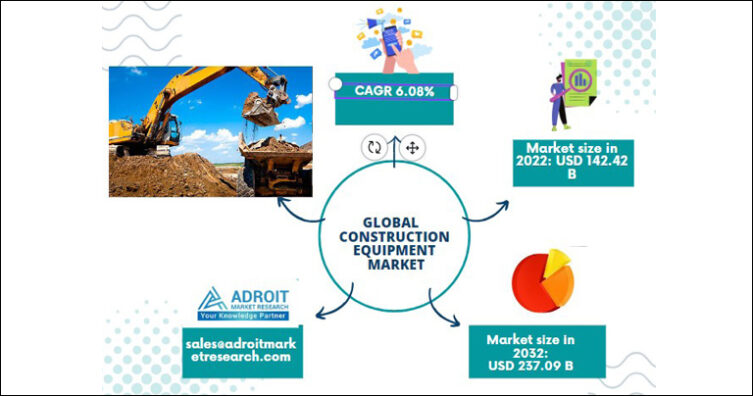The construction equipment market is expected to grow at a 6.8 percent CAGR to USD 237.9 billion by 2031.
According to Adroit Market Research, the global market for construction equipment was valued at USD 142.42 billion in 2021 and is anticipated to rise at a CAGR of 6.8% from 2022 to 2031, reaching USD 237.9 billion.
In the construction industry, a variety of machines and tools are employed to complete various tasks linked to building, infrastructure development, and other construction projects. These tools and machines are referred to as “construction equipment.” These tools are intended to increase the effectiveness, speed, and safety of construction operations. Construction machinery may range widely in size and complexity, and depending on its use and purpose, it is frequently divided into numerous classes. Construction and infrastructure, manufacturing, and oil and gas are just a few of the industries that the worldwide market for construction equipment spans.
Numerous regions were making significant investments in infrastructure development initiatives, including building roads, bridges, airports, and ports. As a result, there was a greater need for construction equipment to complete these projects. The construction of residential and commercial structures was driven by the continuous urbanization trend, which increased the demand for construction tools. Technology improvements in the construction equipment sector included the incorporation of telematics, GPS, and IoT (Internet of Things) technology. The effectiveness, security, and productivity of construction equipment were all being improved by these advancements. The use of more ecologically friendly construction equipment, such as electric and hybrid vehicles, is being prompted by strict environmental restrictions.
As construction firms and contractors looked for affordable methods to obtain equipment without making significant upfront commitments, the rental industry for construction equipment was expanding. The demand for construction equipment was being driven by the significant infrastructure investments being made by emerging nations. As outdated machines were replaced with newer, more efficient versions, aging construction equipment was creating replacement demand in several industries. Due to delays in the supply chain and other project challenges, the COVID-19 pandemic initially caused some interruptions in the market for construction equipment.
Earthmoving and site preparation were both transformed by these devices. Wartime inventions boosted the building sector. During this time, hydraulic systems were improved and started to be widely employed in construction equipment. Particularly in the United States, there was a construction boom following World War II. Various kinds of heavy machinery, such as motor graders, loaders, and excavators, were developed as a result. Automation and computer technology were integrated into construction equipment in the second part of the 20th century. This resulted in the creation of more accurate and effective machinery as well as GPS-guided devices for grading and excavation.
Construction equipment that is cleaner and more fuel-efficient, including electric and hybrid vehicles, has been developed in response to worries about emissions and their effects on the environment. Recent advancements in construction equipment include the creation of autonomous construction trucks, enhanced safety measures, and the use of telematics for remote monitoring and diagnostics. The importance of sustainability in the building is rising. Equipment with a low environmental effect has been developed as a result, including electric excavators and construction machinery driven by renewable energy sources.
The market for renting construction machinery has been expanding. Due to the fact that renting provides builders and construction companies with an affordable alternative, businesses may profit from this by growing existing rental fleets or going into the rental sector. It might be financially rewarding to develop online marketplaces for renting and managing construction-related equipment, much like Uber or Airbnb. By connecting equipment owners with contractors searching for certain machinery, these platforms streamline the leasing process. Developing nations continue to make significant investments in the construction of their infrastructure, particularly in Asia, Africa, and Latin America. Suppliers and manufacturers might look at these markets for potential growth prospects.
Due to significant demand in the building and infrastructure sector, Asia-Pacific had the greatest market share for construction equipment in 2021 and is expected to maintain its top spot over the projected period. a number of major companies are increasing their presence in the Asia-Pacific region to support the region’s rising oil & gas, mining, and other sectors as well as the field of construction.
Cookie Consent
We use cookies to personalize your experience. By continuing to visit this website you agree to our Terms & Conditions, Privacy Policy and Cookie Policy.





















